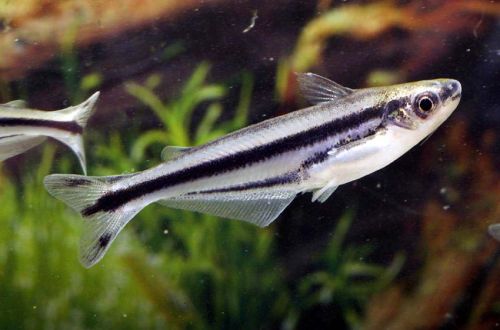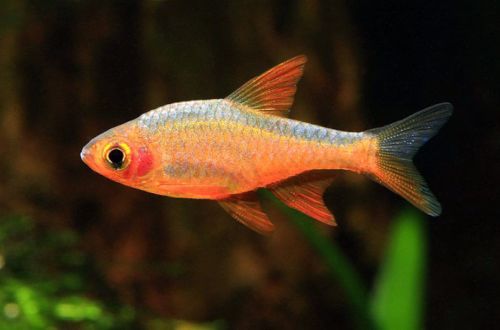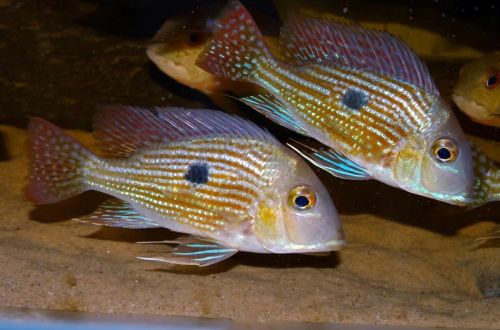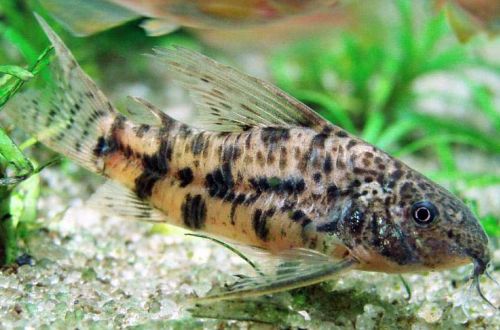
Striped glass catfish
The striped glass catfish, scientific name Pareutropius buffei, belongs to the Schilbeidae family. A peaceful friendly species, it will make a great addition to the community of almost any freshwater aquarium. It is quite easy to maintain if the recommended requirements for its care are observed.

Contents
Habitat
It is found in vast areas of the Congo Basin from Guinea to Nigeria in the equatorial part of the African continent. It lives in numerous rivers flowing under the canopy of moist rainforests.
Brief information:
- The volume of the aquarium – from 70 liters.
- Temperature – 24-28°C
- Value pH — 6.0–7.5
- Water hardness – soft to medium hard (8-15 dGH)
- Substrate type – sandy dark
- Lighting – preferably subdued
- Brackish water – no
- Water movement – light or moderate
- The size of the fish is about 8 cm.
- Food – any food
- Temperament – peaceful
- Keeping a group of at least 6 individuals
Description
Adult individuals reach a length of about 8–10 cm. The shape of the body slightly resembles classical catfish. Belonging to the latter is given out by a somewhat flattened head with antennae, a long anal fin stretching from the tail to the middle of the body, and a dorsal fin with a sharp first ray. The coloration is silvery, partly transparent, with several dark horizontal stripes. There are black spots on the tips of the tail.
Outwardly, it resembles another closely related species – the African glass catfish, which, unlike the Striped glass catfish, has only one black stripe.
African and Striped glass catfish
 Visual differences between two closely related species, the African glass catfish and the striped glass catfish
Visual differences between two closely related species, the African glass catfish and the striped glass catfish
Sexual dimorphism is weakly expressed, males and females are practically indistinguishable from each other.
Food
Accepts all types of dry, frozen and live food. The main condition is that they should be sinking, and the diet should be varied.
Maintenance and care, arrangement of the aquarium
The minimum volume of an aquarium for a flock of 6-8 fish starts from 100 liters. The design uses dense thickets of plants, including floating ones, shelters in the form of snags and other decorative elements. All this is located in such a way as to preserve free areas for swimming. A dark substrate is preferred as it will accentuate the light coloration of the fish.
Catfish places high demands on water quality (absence of pollution), so the presence of a productive filtration system is a must. Aquarium maintenance comes down to regular cleaning of the soil from organic waste and weekly replacement of part of the water (15–20%) with fresh water. Otherwise, it is very unpretentious, feels great in slightly acidic soft or medium hard water.
Behavior and Compatibility
Peaceful calm fish, live in small groups of 6 or more individuals. When kept alone, they become shy, may refuse food. Compatible with other calm species of similar size and temperament. An excellent addition to the community of fish in West African biotope aquaria.
Breeding / breeding
In favorable conditions, the mating season can begin at any time during the year. The approach of spawning can be determined by appearance, some fish are noticeably rounded – these will be females filled with caviar.
Spawning is preferably carried out in a separate tank with a volume of 20 liters or more in order to protect future offspring from neighbors in the aquarium and their own parents who can eat their caviar. The spawning aquarium is filled with water from the main aquarium, and as a substrate for spawning, where the eggs will be laid, thickets of mosses (for example, Java moss) or artificial plants are used. From the equipment you will need to install a heater and a simple airlift filter, the lighting system may consist of a single lamp.
The largest and roundest fish are placed in a spawning aquarium, when white eggs are visible in the thickets, the newly-born parents are transplanted back. The process sometimes drags on for several days, so you should not forget to clean the aquarium regularly. In small volumes, water becomes contaminated very quickly.
Fish diseases
The main cause of most diseases is unsuitable living conditions and poor-quality food. If the first symptoms are detected, you should check the water parameters and the presence of high concentrations of hazardous substances (ammonia, nitrites, nitrates, etc.), if necessary, bring the indicators back to normal and only then proceed with treatment. Read more about symptoms and treatments in the Aquarium Fish Diseases section.





